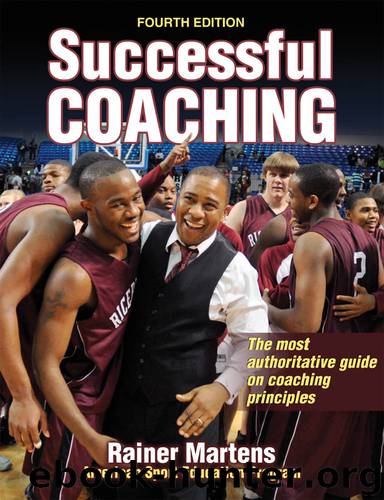Successful Coaching by Rainer Martens

Author:Rainer Martens
Language: eng
Format: epub
ISBN: 9781450400510
Publisher: Human Kinetics
Method 4: Variable Practice
Based on what you’ve learned so far, consider the following two methods of practicing hitting baseballs. In option A, players hit 15 fastballs, then 15 curveballs, and then 15 change-ups; this is called blocked practice. In option B, they hit the same number of fastballs, curves, and change-ups, but the pitcher randomly selects these three pitches for the batter to hit; this is called variable practice.
Would you choose option B? If so, you’re right—but why? Are you thinking it’s because this type of practice is closer to what happens in actual games, when hitters do not know what pitch is coming? Right again, but why is that important? Part of learning to hit is learning to distinguish between fastballs, curves, and change-ups and then deciding what pitch to swing at. It’s about decision making!
Three researchers (see Vickers 2007) studied these two practice situations for 12 practice sessions. As you can see in figure 11.3, for the first 8 practice sessions the blocked group performed better, but after the 8th practice they did not improve. The variable practice group continued to improve and eventually went on to hit better than the blocked group, getting three more hits per 45 pitches than the blocked group got during the 12th practice session.
From this study and many others we now know that variable practice, which simulates game conditions, is better than blocked practice, and the primary reason is that variable practice helps players practice making decisions about how to respond to changing situations. But note that the blocked practice group did better initially, and only after sustained practice did the variable group catch up and pass the blocked group.
The fact that blocked practice results in better performances initially seduces many coaches to adopt it. Inevitably, however, athletes cannot go on to higher levels of performance because they do not learn the decision-making skills they need. Commonly, athletes initially struggle more with variable practice—the games approach—because there is more to learn and thus learning takes longer, but learn they do because they have the opportunity to practice what they must do in the game, and as a result they end up performing at a higher level.
The variability you build into your practices can be within a class of technical skills, among various technical skills, and among various tactics. Variability within a class of skills is like the previous baseball hitting example; it could also be passing in basketball, kicking in soccer, skating in hockey, or many other things.
Design practices so athletes have the opportunity to practice deciding which technical skill from their repertoire they want to use in a particular situation. For example, soccer players must have the ability to decide to kick or head the ball to score a goal under various conditions; basketball players must be able to decide to pass, shoot, or drive to the basket; and quarterbacks must be able to choose between passing short or long or keeping the ball and running.
Download
This site does not store any files on its server. We only index and link to content provided by other sites. Please contact the content providers to delete copyright contents if any and email us, we'll remove relevant links or contents immediately.
The Art of Coaching Workbook by Elena Aguilar(50969)
Trainspotting by Irvine Welsh(21518)
Twilight of the Idols With the Antichrist and Ecce Homo by Friedrich Nietzsche(18501)
Fangirl by Rainbow Rowell(9095)
Periodization Training for Sports by Tudor Bompa(8168)
Change Your Questions, Change Your Life by Marilee Adams(7634)
This Is How You Lose Her by Junot Diaz(6782)
Asking the Right Questions: A Guide to Critical Thinking by M. Neil Browne & Stuart M. Keeley(5631)
Grit by Angela Duckworth(5512)
Red Sparrow by Jason Matthews(5390)
Paper Towns by Green John(5087)
Room 212 by Kate Stewart(5035)
Ken Follett - World without end by Ken Follett(4643)
Housekeeping by Marilynne Robinson(4336)
The Sports Rules Book by Human Kinetics(4288)
Double Down (Diary of a Wimpy Kid Book 11) by Jeff Kinney(4204)
Papillon (English) by Henri Charrière(4195)
The Motorcycle Diaries by Ernesto Che Guevara(4009)
Exercise Technique Manual for Resistance Training by National Strength & Conditioning Association(3955)
